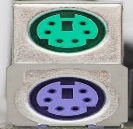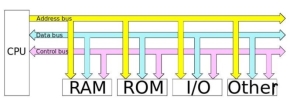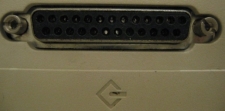|
|
|
However there are 2 types of DVI, DVI-I and DVI-D.
|
|
|
|
|
|
|
|
|
|
|
|
|
|
|
|
|
|
|
The cable has better quality over HDMI and is the best option if you have this interface.
|
|
1. Data sharing - All types of buses found in a computer transfer data between the computer peripherals connected to it.The buses transfer or send data either in the serial or parallel method of data transfer. This allows for the exchange of 1, 2, 4 or even 8 bytes of data at a time. (A byte is a group of 8 bits). Buses are classified depending on how many bits they can move at the same time, which means that we have 8-bit, 16-bit, 32-bit or even 64-bit buses.2. Addressing - A bus has address lines, which match those of the processor. This allows data to be sent to or from specific memory locations.3. Power - A bus supplies power to various peripherals connected to it.4. Timing - The bus provides a system clock signal to synchronize the peripherals attached to it with the rest of the system.The expansion bus facilitates easy connection of more or additional components and devices on a computer such as a TV card or sound card.Bus TerminologiesComputers have two major types of buses:
1. System bus:- This is the bus that connects the CPU to the main memory on the motherboard. The system bus is also called the front-side bus, memory bus, local bus, or host bus.
2. A number of I/O Buses, (I/O is an acronym for input/output), connecting various peripheral devices to the CPU. These devices connect to the system bus via a ‘bridge’ implemented in the processors' chipset. Other names for the I/O bus include “expansion bus", "external bus” or “host bus”.Expansion Bus TypesThese are some of the common expansion bus types that have ever been used in computers:
|
8-Bit ISA card (XT-Bus) | 16-Bit ISA (AT –Bus card) |
8-bit data interface | 16-bit data interface |
4.77 MHZ bus | 8-MHZ bus |
62-pin connector | 62-pin connector |
| 36-pin AT extension connection |
|
VESA slots had an extra set of connectors and thus the cards were larger. The VESA design was backward compatible with the older ISA cards.
Features of the VESA local bus card:-
|
|
|
A device driver communicates with the computer hardwares by computer subsystem or computer bus connected to the hardware. Device Drivers are very essential for a computer system to work properly because without device driver the particular hardware fails to work accordingly means it fails in doing a particular function/action for which it has been created.In a very common way most term it as only a Driver also when someone says Hardware Driver that also refers to this Device Driver.
|
Device Drivers depend upon the Operating System’s instruction to access the device and performing any particular action. After the action they also shows their reactions by delivering output or status/message from hardware device to the Operating system.For Example a printer driver tells the printer in which format to print after getting instruction from OS, similarly A sound card driver is there due to which 1’s and 0’s data of MP3 file is converted to audio signals and you enjoy the music. Card reader, controller, modem, network card, sound card, printer, video card, USB devices, RAM, Speakers etc need Device Drivers to operate.The following figure illustrates the interaction between user, OS, Device driver and the devices:
|
For almost every device associated with the computer system there exist Device Driver for the particular hardware.But it can be broadly classified into two types i.e.,Kernel-mode Device Driver –
This Kernel-mode device driver includes some generic hardwares which loads with operating System as part the OS these are BIOS, motherboard, processor and some other hardwares which are part of kernel software. These includes the minimum system requirement device drivers for each operating system.
Other than the devices which are brought by kernel for working of the system the user also bring some devices for use during the using of a system that devices needs device drivers to functions those drivers falls under User mode device driver. For example user needs any plug and play action that comes under this.
There are also virtual device drivers(VxD), which manages the virtual device. Sometimes we use same hardware virtually at that time virtual driver controls/manages the data flow from different application used by different users to the same hardware.It is essential for a computer to have the required device drivers for all its parts to keep the system running efficiently. Many device drivers are provided by manufactures from beginning and also we can later include any required device driver for our system. Q4) Explain Input devices
|
|
PCI Express Motherboard Expansion Slot PCI Express (or PCIe) is the newest standard for expansion cards on personal computers. PCI Express is meant to replace older standards like PCI and AGP, mentioned below. PCIe provides significantly more bandwidth, allowing for higher performance video cards and network cards. Video cards in particular are the most common consumer use of these slots, since they need high bandwidth for maximum 3D gaming and graphics performance. PCI Express slots have different versions and numbers of lanes.PCI
PCI Motherboard Expansion Slots PCI (Peripheral Component Interconnect) is not to be confused with PCI Express, which is meant to replace it. Unlike PCI Express, PCI is an older standard which provides less bandwidth for expansion cards. In spite of the fact that the standard was created in 1993, new motherboards still ship with PCI slots for compatibility purposes.AGP
AGP Motherboard Expansion Slot The AGP (Accelerated Graphics Port) expansion slot standard was introduced when video cards needed more bandwidth for performance than was provided by PCI. As suggested by the title, AGP slots are used for video cards. However, AGP has been largely phased out in favour of the PCI Express expansion slot standard. Unlike AGP, PCI Express provides higher bandwidth for other types of expansion cards that could use it, such as some newer, high-performance sound and network cards.ExpressCard & PC Card (or PCMCIA)
PCMCIA Motherboard Expansion Slot These standards are designed to be used with portable computers such as laptops. ExpressCard is the successor to PC Card (also known as PCMCIA), and, like PCIe over PCI, has more bandwidth. Unlike PCI, these types of cards are hot-pluggable (which means you can plug them in while your laptop is running, without shutting it down first).ISA
ISA Motherboard Expansion Slot ISA (Industry Standard Architecture) is another type of expansion slot you may have heard of. It was the predecessor to PCI and you’ll only find it on much older computers. Q9) Explain System softwareA9) Software is a part of computer system that contains data or set of instructions. It is considered as set of programs, which is then executed to perform a well-defined function. A program consists of a set of instructions which are used to perform a specific task in an orderly manner.There are two types of software −
|
|
A compiler is processor-dependent and platform-dependent. But it has been addressed by a special compiler, a cross-compiler and a source-to-source compiler. Before choosing a compiler, user has to identify first the Instruction Set Architecture (ISA), the operating system (OS) and the programming language that will be used to ensure that it will be compatible.InterpreterJust like a compiler, is a translator used to convert high-level programming language to low-level programming language. It converts the program one at a time and reports errors detected at once, while doing the conversion. With this, it is easier to detect errors than in a compiler. An interpreter is faster than a compiler as it immediately executes the code upon reading the code.
It is often used as a debugging tool for software development as it can execute a single line of code at a time. An interpreter is also more portable than a compiler as it is not processor-dependent, you can work between hardware architectures.AssemblerAn assembler is is a translator used to translate assembly language to machine language. It is like a compiler for the assembly language but interactive like an interpreter. Assembly language is difficult to understand as it is a low-level programming language. An assembler translates a low-level language, an assembly language to an even lower-level language, which is the machine code. The machine code can be directly understood by the CPU.Examples of TranslatorsHere are some examples of translators per type:
Translator | Examples |
Compiler | Microsoft Visual Studio |
Interpreter | OCaml |
Assembler | Fortran Assembly Program (FAP) |
|
|
|
However there are 2 types of DVI, DVI-I and DVI-D.
|
|
|
|
|
|
|
|
|
|
|
|
|
|
|
|
|
|
|
The cable has better quality over HDMI and is the best option if you have this interface.
|
|
1. Data sharing - All types of buses found in a computer transfer data between the computer peripherals connected to it.The buses transfer or send data either in the serial or parallel method of data transfer. This allows for the exchange of 1, 2, 4 or even 8 bytes of data at a time. (A byte is a group of 8 bits). Buses are classified depending on how many bits they can move at the same time, which means that we have 8-bit, 16-bit, 32-bit or even 64-bit buses.2. Addressing - A bus has address lines, which match those of the processor. This allows data to be sent to or from specific memory locations.3. Power - A bus supplies power to various peripherals connected to it.4. Timing - The bus provides a system clock signal to synchronize the peripherals attached to it with the rest of the system.The expansion bus facilitates easy connection of more or additional components and devices on a computer such as a TV card or sound card.Bus TerminologiesComputers have two major types of buses:
1. System bus:- This is the bus that connects the CPU to the main memory on the motherboard. The system bus is also called the front-side bus, memory bus, local bus, or host bus.
2. A number of I/O Buses, (I/O is an acronym for input/output), connecting various peripheral devices to the CPU. These devices connect to the system bus via a ‘bridge’ implemented in the processors' chipset. Other names for the I/O bus include “expansion bus", "external bus” or “host bus”.Expansion Bus TypesThese are some of the common expansion bus types that have ever been used in computers:
|
8-Bit ISA card (XT-Bus) | 16-Bit ISA (AT –Bus card) |
8-bit data interface | 16-bit data interface |
4.77 MHZ bus | 8-MHZ bus |
62-pin connector | 62-pin connector |
| 36-pin AT extension connection |
|
VESA slots had an extra set of connectors and thus the cards were larger. The VESA design was backward compatible with the older ISA cards.
Features of the VESA local bus card:-
|
|
|
A device driver communicates with the computer hardwares by computer subsystem or computer bus connected to the hardware. Device Drivers are very essential for a computer system to work properly because without device driver the particular hardware fails to work accordingly means it fails in doing a particular function/action for which it has been created.In a very common way most term it as only a Driver also when someone says Hardware Driver that also refers to this Device Driver.
|
Device Drivers depend upon the Operating System’s instruction to access the device and performing any particular action. After the action they also shows their reactions by delivering output or status/message from hardware device to the Operating system.For Example a printer driver tells the printer in which format to print after getting instruction from OS, similarly A sound card driver is there due to which 1’s and 0’s data of MP3 file is converted to audio signals and you enjoy the music. Card reader, controller, modem, network card, sound card, printer, video card, USB devices, RAM, Speakers etc need Device Drivers to operate.The following figure illustrates the interaction between user, OS, Device driver and the devices:
|
For almost every device associated with the computer system there exist Device Driver for the particular hardware.But it can be broadly classified into two types i.e.,Kernel-mode Device Driver –
This Kernel-mode device driver includes some generic hardwares which loads with operating System as part the OS these are BIOS, motherboard, processor and some other hardwares which are part of kernel software. These includes the minimum system requirement device drivers for each operating system.
Other than the devices which are brought by kernel for working of the system the user also bring some devices for use during the using of a system that devices needs device drivers to functions those drivers falls under User mode device driver. For example user needs any plug and play action that comes under this.
There are also virtual device drivers(VxD), which manages the virtual device. Sometimes we use same hardware virtually at that time virtual driver controls/manages the data flow from different application used by different users to the same hardware.It is essential for a computer to have the required device drivers for all its parts to keep the system running efficiently. Many device drivers are provided by manufactures from beginning and also we can later include any required device driver for our system. Q4) Explain Input devices
|
|
PCI Express Motherboard Expansion Slot PCI Express (or PCIe) is the newest standard for expansion cards on personal computers. PCI Express is meant to replace older standards like PCI and AGP, mentioned below. PCIe provides significantly more bandwidth, allowing for higher performance video cards and network cards. Video cards in particular are the most common consumer use of these slots, since they need high bandwidth for maximum 3D gaming and graphics performance. PCI Express slots have different versions and numbers of lanes.PCI
PCI Motherboard Expansion Slots PCI (Peripheral Component Interconnect) is not to be confused with PCI Express, which is meant to replace it. Unlike PCI Express, PCI is an older standard which provides less bandwidth for expansion cards. In spite of the fact that the standard was created in 1993, new motherboards still ship with PCI slots for compatibility purposes.AGP
AGP Motherboard Expansion Slot The AGP (Accelerated Graphics Port) expansion slot standard was introduced when video cards needed more bandwidth for performance than was provided by PCI. As suggested by the title, AGP slots are used for video cards. However, AGP has been largely phased out in favour of the PCI Express expansion slot standard. Unlike AGP, PCI Express provides higher bandwidth for other types of expansion cards that could use it, such as some newer, high-performance sound and network cards.ExpressCard & PC Card (or PCMCIA)
PCMCIA Motherboard Expansion Slot These standards are designed to be used with portable computers such as laptops. ExpressCard is the successor to PC Card (also known as PCMCIA), and, like PCIe over PCI, has more bandwidth. Unlike PCI, these types of cards are hot-pluggable (which means you can plug them in while your laptop is running, without shutting it down first).ISA
ISA Motherboard Expansion Slot ISA (Industry Standard Architecture) is another type of expansion slot you may have heard of. It was the predecessor to PCI and you’ll only find it on much older computers. Q9) Explain System softwareA9) Software is a part of computer system that contains data or set of instructions. It is considered as set of programs, which is then executed to perform a well-defined function. A program consists of a set of instructions which are used to perform a specific task in an orderly manner.There are two types of software −
|
|
A compiler is processor-dependent and platform-dependent. But it has been addressed by a special compiler, a cross-compiler and a source-to-source compiler. Before choosing a compiler, user has to identify first the Instruction Set Architecture (ISA), the operating system (OS) and the programming language that will be used to ensure that it will be compatible.InterpreterJust like a compiler, is a translator used to convert high-level programming language to low-level programming language. It converts the program one at a time and reports errors detected at once, while doing the conversion. With this, it is easier to detect errors than in a compiler. An interpreter is faster than a compiler as it immediately executes the code upon reading the code.
It is often used as a debugging tool for software development as it can execute a single line of code at a time. An interpreter is also more portable than a compiler as it is not processor-dependent, you can work between hardware architectures.AssemblerAn assembler is is a translator used to translate assembly language to machine language. It is like a compiler for the assembly language but interactive like an interpreter. Assembly language is difficult to understand as it is a low-level programming language. An assembler translates a low-level language, an assembly language to an even lower-level language, which is the machine code. The machine code can be directly understood by the CPU.Examples of TranslatorsHere are some examples of translators per type:
Translator | Examples |
Compiler | Microsoft Visual Studio |
Interpreter | OCaml |
Assembler | Fortran Assembly Program (FAP) |





































































